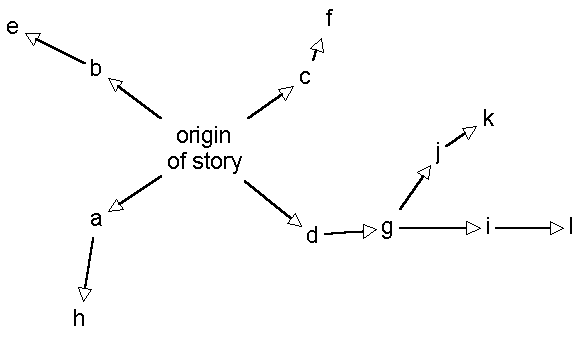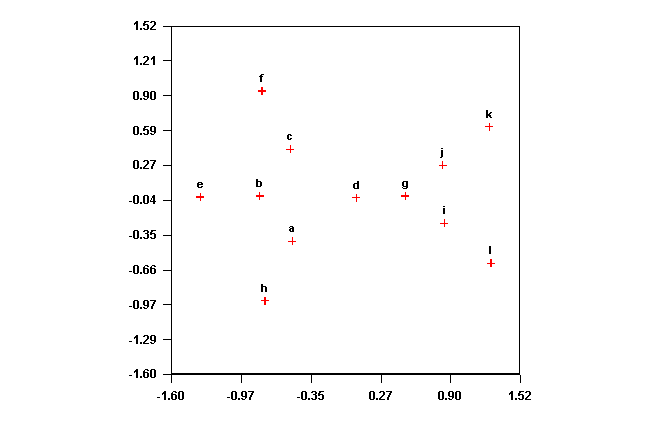
These three chapters concern legends involving "dangerous products", including mice in Coke bottles, and Pop Rocks.
Are similar folktales invented independently (polygenesis)? Or is it always a diffusion process?
Two points about this. First, how many people are likely to hear about an event if each person tells others about it? Here's what happens if each person tells 5 new people the story.
|
Time |
Added |
Cumulative |
|
0 |
1 |
1 |
|
1 |
5 |
2 |
|
2 |
25 |
7 |
|
3 |
125 |
32 |
|
4 |
625 |
157 |
|
5 |
3,125 |
782 |
|
6 |
15,625 |
3,907 |
|
7 |
78,125 |
19,532 |
|
8 |
390,625 |
97,657 |
|
9 |
1,953,125 |
488,282 |
|
10 |
9,765,625 |
2,441,407 |
|
11 |
48,828,125 |
12,207,032 |
|
12 |
244,140,625 |
61,035,157 |
|
13 |
1,220,703,125 |
305,175,782 |
|
14 |
6,103,515,625 |
1,525,878,907 |
|
15 |
30,517,578,125 |
7,629,394,532 |
This assumes that people's social networks do not form clumps, so that if you and I are friends, then we also have friends in common, so when I tell the story to 5 friends, and you do the same, we don't end up "infecting" 10 new people with the story, because some of your friends are the same as mine, so they get the hear the story twice.
Here's what happens when, again, each person tells 5 others, but the social network is very dense so that, each of your friends is friends with an average 3.5 of your other friends:
|
Time |
Added |
Cumulative |
|
0 |
1 |
1 |
|
1 |
2 |
2 |
|
2 |
2 |
4 |
|
3 |
3 |
6 |
|
4 |
5 |
9 |
|
5 |
8 |
14 |
|
6 |
11 |
22 |
|
7 |
17 |
33 |
|
8 |
26 |
50 |
|
9 |
38 |
76 |
|
10 |
58 |
114 |
|
11 |
86 |
172 |
|
12 |
130 |
258 |
|
13 |
195 |
388 |
|
14 |
292 |
583 |
|
15 |
438 |
875 |
Now the second point. You can partially reconstruct the diffusion by comparing versions of stories: If I got it from you, we are likely to have very similar versions. And if you got it from someone, then my version is probably fairly similar to theirs too, but not quite as similar as to yours.

In the diagram, h's version may be quite different from f's, just as l's version will be different from d's. Still, we may be able to reconstruct the whole picture because (1) there is a path of incremental differences leading from, say, d's version to l's version, and (2) as you get near the origin, all the stories are more alike.
Suppose you obtain stories from each person, above, without knowing how they are connected to each other. You study each version, and quantify the amount of of difference in details between them. You get the following matrices of differences between stories.
|
a |
b |
c |
d |
e |
f |
g |
h |
i |
j |
k |
l |
|
|
a |
0 |
2 |
2 |
2 |
3 |
3 |
3 |
1 |
4 |
4 |
5 |
5 |
|
b |
2 |
0 |
2 |
2 |
1 |
3 |
3 |
3 |
4 |
4 |
5 |
5 |
|
c |
2 |
2 |
0 |
2 |
3 |
1 |
3 |
3 |
4 |
4 |
5 |
5 |
|
d |
2 |
2 |
2 |
0 |
3 |
3 |
1 |
3 |
2 |
2 |
3 |
3 |
|
e |
3 |
1 |
3 |
3 |
0 |
4 |
4 |
4 |
5 |
5 |
6 |
6 |
|
f |
3 |
3 |
1 |
3 |
4 |
0 |
4 |
4 |
5 |
5 |
6 |
6 |
|
g |
3 |
3 |
3 |
1 |
4 |
4 |
0 |
4 |
1 |
1 |
2 |
2 |
|
h |
1 |
3 |
3 |
3 |
4 |
4 |
4 |
0 |
5 |
5 |
6 |
6 |
|
i |
4 |
4 |
4 |
2 |
5 |
5 |
1 |
5 |
0 |
2 |
3 |
1 |
|
j |
4 |
4 |
4 |
2 |
5 |
5 |
1 |
5 |
2 |
0 |
1 |
3 |
|
k |
5 |
5 |
5 |
3 |
6 |
6 |
2 |
6 |
3 |
1 |
0 |
4 |
|
l |
5 |
5 |
5 |
3 |
6 |
6 |
2 |
6 |
1 |
3 |
4 |
0 |
In the matrix, you can see that e's and k's stories were very different, while a's and h's were quite similar. Computer programs can then used to figure out what social network (i.e., what connections between people) would be consistent with such a matrix of differences, assuming that stories tend to change by approximately the same amount when going from person to person.
Here's what one program drew, based on the matrix above:

The program does not draw lines. Another program adds lines between all nodes with the minimum difference (in this case 1):
If legends begin with actual events, then it is also possible that the event occurs in more than one place (e.g., Kentucky Fried Rat), leading to multiple independent origins of a similar story.
There were 45 court cases (that were appealed) from 1914 to 1976 involving a mouse in a soft drink bottle. In all cases, the fact of the mouse in the bottle was not at issue. In addition there are cases of mice in other products, and cases of other animals & objects in bottles.
Fine calculates that it is possible that 180,000 cases of mouse problems might have been brought to lower courts. If each person involved told 20 acquaintances, there could be 3.6 million people with 2nd hand knowledge of a similar event. These people then tell others, perhaps altering the story in systematic ways. Some people are then likely to hear the story from different sources, with different details. This possibly reduces the credibility of the stories, and may act to simplify the story (only the shared facts get transmitted, aside from localization). When slightly different stories are heard (perhaps because they reflect different actual cases), people probably assume they are all one story, and try to blend them.
Do stories flow through all ties in a social network indiscriminately? Or do transmitters tell only a select subset of individuals they know?
Kids asked to fill out questionnaires listing their best friends. It was assumed that best friendships provided the best opportunities for transmission.
A window was broken at the grammar school. The police questioned 5 kids ("suspects"). Many stories involving who broke the window and about the interviews with the police were circulated. Reports of managing the police and convincing the "pigs" of their innocence were widely circulated.
46% of the kids who heard it through another Little League player heard it from one of their best friends.
First told by Ronald, one of the lower status boys. Later Stewart (most popular boy) claimed he had heard the story prior to Ronald's telling. The pop rocks became scarce due to distribution problem, but the boys heard that they had been declared illegal in Minnesota. Variants of the story change the locations where the child died, and the number of pellets he ate.
Survey study showed that at least half of the kids had heard of the death rumor, and half had heard the illegal rumor. Most who heard the stories believed them.
The girl's softball players' network. Two cliques. Asked each girl who she heard it from. Barb says Lisa, but her version is not like Lisa's version -- it is more Jody's or Michelle's, both of whom are in her clique. Similarity of stories, combined with knowledge of the friendship network, may be a more reliable way of tracing the diffusion of a story than just asking people who they heard it from.
Although observer recorded Ronald (the low status kid) telling the story to the other kids early on, none of the kids recalled that. Instead, they recall Stewart (the popular kid) as the originator. They also say they heard the story from Stewart long before he himself claimed to hear it. The details in his version are also the most agreed upon.
In summary, stories do not seem to be indiscriminately told to all in the network. And which version is accepted seems to have to do with sociometric status. It may be that one of the functions of leadership is to bring people mentally in to line: to give them all a standard story that they all accept, thereby enhancing communication and coordination. The leader creates a pocket of cultural and cognitive homogeneity around him or her.
At the same time, we can speculate that what makes leaders in the first place is the ability to tell good stories -- stories that impart understanding and which motivate action.
People used to think that folklore was a quaint trait of uneducated, simple rural people. Yet folklore (urban legends, myths, rumors, tales) thrives in our society today. It is likely that most of our "knowledge" is heard 3rd hand from other people. As societies change and people react to the changes, new legends are born (e.g., Pop Rocks, microwaved pets).
Fear of poisoned or contaminated food has always been great. Such stories always seem somewhat plausible. Today, most of these involve large corporations, typically the biggest corporation in its product category. The worms in hamburgers stories originated with Wendy's (who advertised how juicy the burgers were), but soon switched to McDonalds, the market leader. Soft drink contaminants are associated Coke, and fried chicken problems with Kentucky Fried Chicken.
In only 2 of 115 accounts by Americans is the establishment not a national chain. In contrast, in Europe, the locale of such rumors is almost always a small ethnic restaurant, such as yugoslavian, italian or chinese. In the US, there is alienation from the food-preparation function. It's been taken over by large corporations.
Rats and mice are particularly common in the stories. They are plausible because so relevant, and may serve symbolic value: urban decay.
Some stories posit deliberate sabotage, others neglect due to high volume/impersonal handling.
The results are usually painful for the victim (heart attack, vomiting, mental institution, poisoning), but in some cases they sue and get thousands. There are never negative consequences for the corporations other than paying settlements, which are often seen cynically as a minor annoyance to the corporation.
Victims are usually female. Perhaps makes the story more awful. But why not children? Maybe punishment for neglecting the kitchen. Perhaps people are still uncomfortable with women leaving "their place" in society and entering "men's place". This would fit with the AIDS Mary legends and the Promiscuous Cheerleader story and the Hook legends.